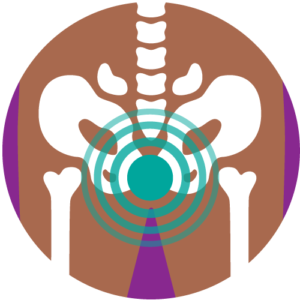
What is it?
The Pelvic Floor is often the missing piece to properly treating low back, hip, or tailbone pain.
WHAT COULD CAUSE IT?
- Pregnancy
- Tailbone injury
- Abdominal surgery – C-section, hernia repair, hysterectomy, bowel repair
- Pelvic Fracture
- Overuse of pelvic muscles
- Weak core
- Poor breathing
HOW DO I KNOW IF I NEED IT?
- Pain during urination or when the bladder is full
- Urine leakage when coughing, sneezing or laughing
- A strong urge to urinate yet feeling unable to empty the bladder/ recurring UTIs
- Painful bowel movements and/or constipation
- Pain during or after sexual activity
- Pain during gynecological exams or when using a tampon
- Prolapse - the feeling of heaviness or pelvic pressure, like organs, are slipping out
- Lower abdominal pain, pelvic pain, genital pain
- Low back pain, groin pain, hip pain, tailbone pain
What conditions can pelvic floor treatment help with?
POSTPARTUM
PHASE
After pregnancy, women may experience pelvic pain, the feeling of heaviness or pressure of pelvic organs (prolapse), complications from C-section scars, and separation of abdominal muscles (DRA). Get an assessment after giving birth.
PELVIC
PAIN
Pain in pelvic area includes genitals, perineum, pubic area, bladder area, lower abdomen, groin area. Pain may be referred to low back, groin, tailbone and hips. Physical Therapy is a great way to relieve these symptoms
URINARY INCONTINENCE
Get help with symptoms such as urinary leakage with cough, sneezing, or exercise; urinary frequency, pain, and burning with urination; difficulty starting urination and getting up several times a night to use the bathroom.
SEXUAL
DYSFUNCTION
Pain or discomfort with sexual activity or intercourse can stem from the pelvic floor. Issues with sexual activity may increase other symptoms like pelvic pain and urinary frequency. Don’t wait to get an assessment.
What should I expect during a Pelvic Floor assessment?
Like traditional Physical Therapy, your PT will take a history of your symptoms and check your range of motion, strength, and flexibility, amongst other special tests, to get to the bottom of your pain or dysfunction. We may assess your breathing pattern and check for tenderness and trigger points in your abdomen, back, and hips. Then, with the patient lying on their back, an external and /or internal exam of the vaginal area or rectum will be done – this checks for signs of skin irritation, atrophy, resting muscle tone, and laxity. Internal exams are only performed with consent! A gloved and lubricated finger is inserted to check muscle integrity, strength, and to assess for pain and referred symptoms.
